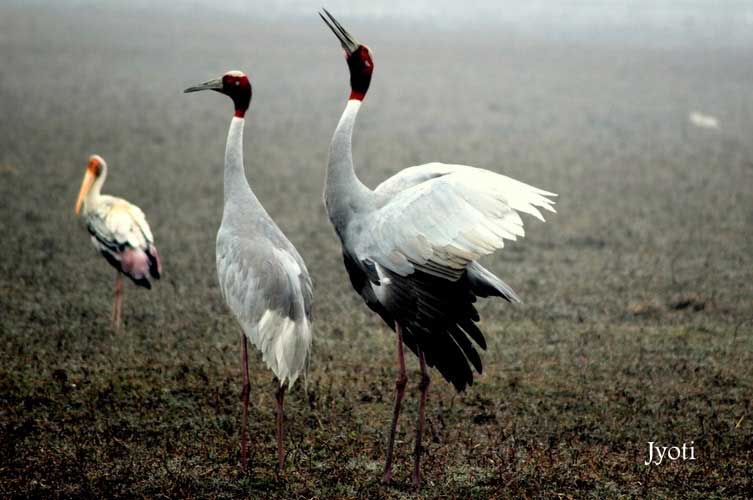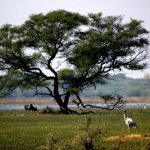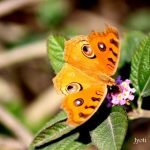Near the bustling city of Delhi, there are several natural bird sanctuaries that offer a glimpse into the lives of India’s beautiful and exotic birds.
With more than 1,000 species of birds, India is a paradise for birdwatchers. Here are seven of the best bird sanctuaries near Delhi, each with its own unique charm and attractions.
When I visited ‘Bharatpur Bird Sanctuary’ in the month of December last year, I noticed people running to see and take pictures of two birds more sincerely than others.
These birds were Sarus Crane and Painted Stork. Interestingly, birds like Common coot and Northern Shoveler, which migrate during winters, did not catch much attention.
Perhaps because they are found in good numbers everywhere. In the words of a fellow birding enthusiast- ‘Common coot to coot coot ke bhari hai yaha’ (This place is stuffed with Common Coots).
While both Sarus Crane and Painted Stork attract attention due to their big size, Painted Stork is particularly liked by birders for its colorful feathers. Sarus Crane, at the same time, is famous for its red head and upper neck; it is also considered as the tallest flying bird.
Both Sarus Crane and Painted Stork prefer shallow wetlands and are capable of living along with human settlements. It is for this reason I am writing this post.
When birds live nearby the agricultural fields cultivated by humans, they become habitual to human presence. This ease to have humans around is the perfect setting any birding fan would prefer. Of course, you cannot go and touch these birds but can watch and take their pictures from a fairly close distance.
In this article, I am going to tell you about three of these bird sanctuaries near Delhi region where you can see birds alongside human settlements. These wetlands offer you chances to see both local as well as migratory birds.
7 Best Natural Bird Sanctuaries Near Delhi
I am calling these ‘Natural’ Bird Sanctuaries because most of them are not protected by any public authority. These are open wetlands surrounded by villages and agricultural fields.
1. Dighal Wetlands, Jhajjhar, Haryana
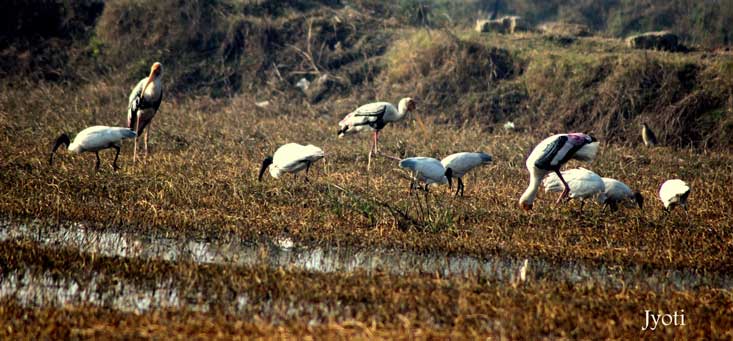
We started from East Delhi early morning and reached Dighal in about two hours. Right after we crossed the urban settlements and entered the agricultural area, we were warmly welcomed by Kingfishers, Drongos, Bulbuls, and Sparrows in huge numbers.
These were just sitting on every tree and electricity wire. Moreover, clean fresh air and flowering mustard fields added to the charm.
There’s no ‘one’ wetland but you will find birds in every small and big water body in and around Dighal. This was my first visit to open wetlands and I was pleasantly surprised to see many varieties of birds in one sight.
On the left side of the road, there were painted storks, Black-headed Ibises, Glossy Ibises, Spoonbills, and Black-winged Stilts. On the right side, I saw many Pond Herons, Intermediate Egrets, Greater Coucal, and Doves.
For the fact that these birds were habitual of human presence, I could go closer and take their pictures better than earlier.
When we moved a bit ahead, we saw a pond full of Northern Shovelers, Northern Pintails, Indian Cormorants and Common Coots. We could also sight little Grebe, Purple Heron, and Common Teal, although less in numbers.
Moving a little further, we saw another pond full of Bar-headed Geese. It was such a wonderful sight that we could not resist stopping the car to spend a few minutes with those chatty birds.
We also spotted many Avocets and Godwits on our way. This was the first time I could see these birds from so close. I was overwhelmed by this very fact 🙂
It is a good idea to club your visits to this wetland along with the nearby bird sanctuary. Bhindawas Bird Sanctuary has situated around 36 km from Dighal. It’s a nice huge piece of land (both dry and wet) with no constructed boundaries or tickets.
It is a natural setup where you can see many birds in abundance. Since it’s a huge area you may need to use binoculars to get access to far floating/flying/resting birds.
2. Bhindawas Bird Sanctuary, Jhajjar, Haryana
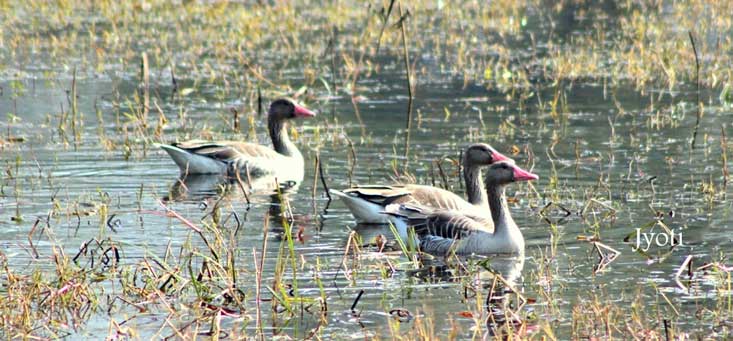
The scenic beauty of the Bhindawas Bird Sanctuary attracts many to visit, it was a quick one-day plan when we first visited this sanctuary. And while writing about it, I have visited there three times.
Bhindawas Bird Sanctuary is in district Jhajjar, Haryana, Its 3 hours distance from Delhi makes it one of the best bird sanctuaries near Delhi you can visit in a single day. The place is a visual treat for birdwatchers and nature lovers. The Sanctuary is spread across an area of 1074 acres.
Bhindawas opens at 6:30 AM and closes at 5 pm in winter and opens at 6 AM and closes at 6 PM in summer. There is no entry fee. You can call 09467456002 for any other queries you have.
A large variety of birds are spotted here including Common Pochard, Ruddy Shelduck, Eurasian Wigeon, White-throated Kingfisher. You could also get to see Neelgai (Blue Bull) and Jungle Cat here.
The best time to visit Bhindawas Bird Sanctuary is between December and January.
3. Basai Wetlands, Gurugram, Haryana
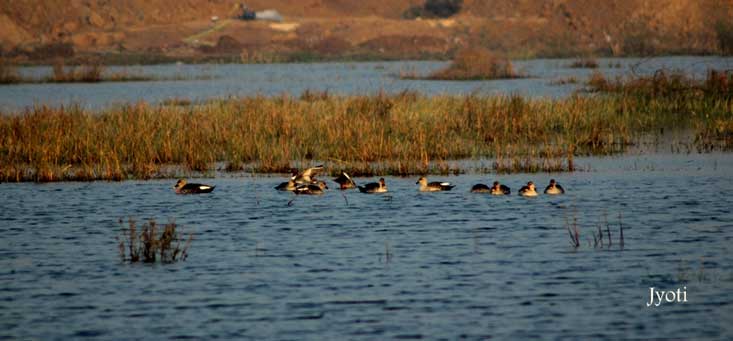
I have been a member of many birders’ groups on Facebook where people post pictures, videos, and experiences related to birds, nature, and the like.
One fine day, I saw someone posting a bird’s picture taken at Basai Wetlands. By this time, I was still under the influence of Dighal and immediately planned my trip to Basai.
The good thing about all these locations is that they are in the vicinity of Delhi and you can anytime plan a day or even a half-day trip.
Three fellow bird enthusiasts joined us and it looked like a real birding mission. When we reached Basai we were not very sure of getting to see birds because a lot of construction was going on around the area.
However, as we moved in we saw wetlands on two sides of a mud road. Grey-headed Swamphen (or Purple Swamphen), Ibises, and Spot-billed Ducks were the first few birds we saw.
Like other places, this wetland was also full of Common Coots. Apart from other familiar and local birds, I saw Pied Kingfisher, Citrine Wagtail, Common Hoopoe, and Asian Pied Starling for the first time.
It was a good site and time to see Herons’ (both Pond and Purple) feeding behavior; they were busy catching and eating fish. Moreover, we could also observe Ibises’ flight in groups along with a pair of flying Sarus Crane.
Basai Wetlands are very close to Sultanpur Bird Sanctuary in Gurugram. Visit this sanctuary is a must while visiting Basai wetlands.
There’s a continuing effort made by the authorities to make the bird sanctuary a place for a better birding experience. New sites are created and earth roads are constructed to bring birds close to your reach.
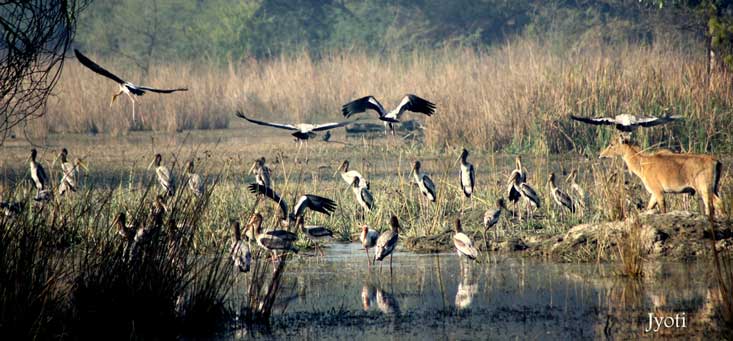
4. Bharatpur Bird Sanctuary, Bharatpur, Rajasthan
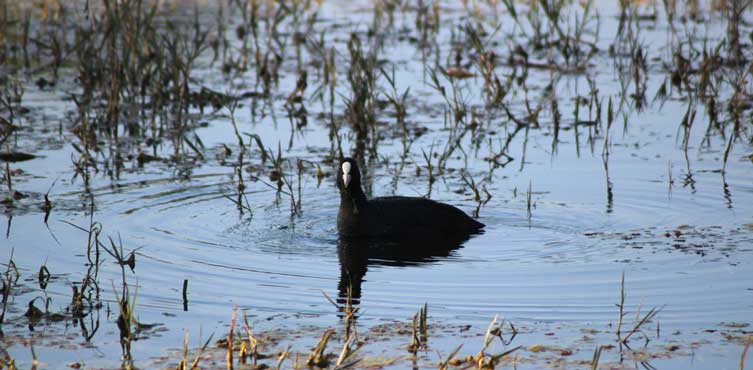
It is the best bird sanctuary near Delhi, Bharatpur Bird Sanctuary is India’s largest. And it was a perfect weekend getaway plan for Delhiite bird watchers like us.
We have spotted many amazing native birds in this sanctuary including Sarus Crane and Painted Stork. The sanctuary is also famous for migratory birds, who fly from distant places in the winter season.
The thickly wooded area and marshy land offered numerous bird watching opportunities in their natural habitat. The sanctuary is located in Bharatpur, Rajasthan. It opens at 7 PM and closes at 5 PM. The entry fee is Rs. 50/- with no extra camera fee.
It is closed in the months of May and June. You could spot pelicans, ducks, larks, warblers, and flycatchers here. Check out my detailed guide on Bharatpur bird Sanctuary for more details.
5. Dhanauri Wetlands, Thasrana, Uttar Pradesh
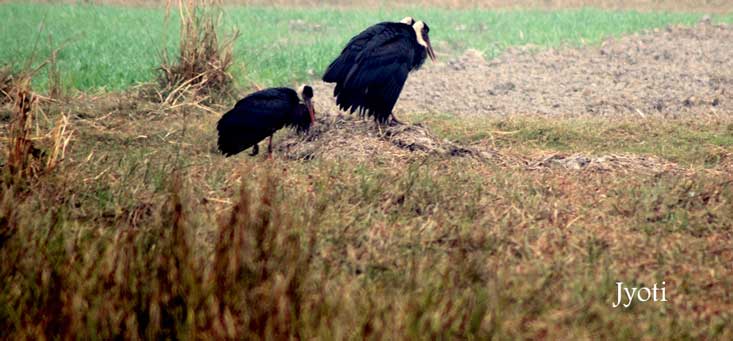
During our Dighal trip, another birder suggested us to visit Dhanauri located a little ahead of Greater Noida. I also saw an online picture of Sarus Crane dancing in the fields at Dhanauri.
We had not yet got any chance to see the Sarus crane from close; therefore, we planned a half-day trip to Dhanauri. It is around 28 km away from Greater Noida.
Dhanauri wetlands constitute primarily two sides of wetlands alongside the cultivated agricultural land. The first thing we saw in these wetlands was a pair of Sarus Crane.
We could go considerably close to them and notice their behavior and calls. Later we saw at least two more pairs of them.
The place was full of Painted Storks, Herons, Ibises, Cormorants, and many migratory birds (like Greylag Goose, Common Coot, Common Pochard, and Northern Shoveler). At this place, Bronze-winged Jacana, Grey-backed Shrike, Woolly-necked Stork, and Water Rail too caught our attention.
Our journey with birds is still new and we make friends with at least four to five new varieties of birds every time we visit a bird sanctuary.
We clicked pictures of all these birds in their natural habitat. Although it was a foggy day and we had to wait for the sun, we were happy with the details. Eventually, in the presence of a few sporadic sun rays, we were able to get somewhat clearer pictures.
You can club your visit to Dhanauri wetlands with Surajpur Bird Sanctuary. It is situated in Greater Noida and hosts many Asian Antelopes along with various varieties of birds.
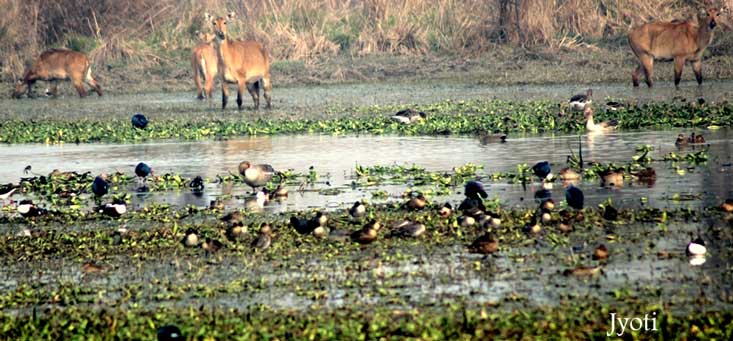
Common Teal, Northern Shoveler, Black-winged Stilt, Grey-headed Swamphen, Bar-headed Goose, Common Coot, Greylag Goose, Northern Pintail, Pochard, and Black-tailed Godwits were in good numbers at this sanctuary.
Apart from birds, this sanctuary also provides you a good trek of about three km, away from urban hassle and noise. I was told that one has to take special permission to visit this place but we could enter inside with no such letters or tickets on 26th Jan this year. In fact, the sanctuary was full of visitors.
6. Lakh Bahosi Bird Sanctuary, Kannauj, Uttar Pradesh
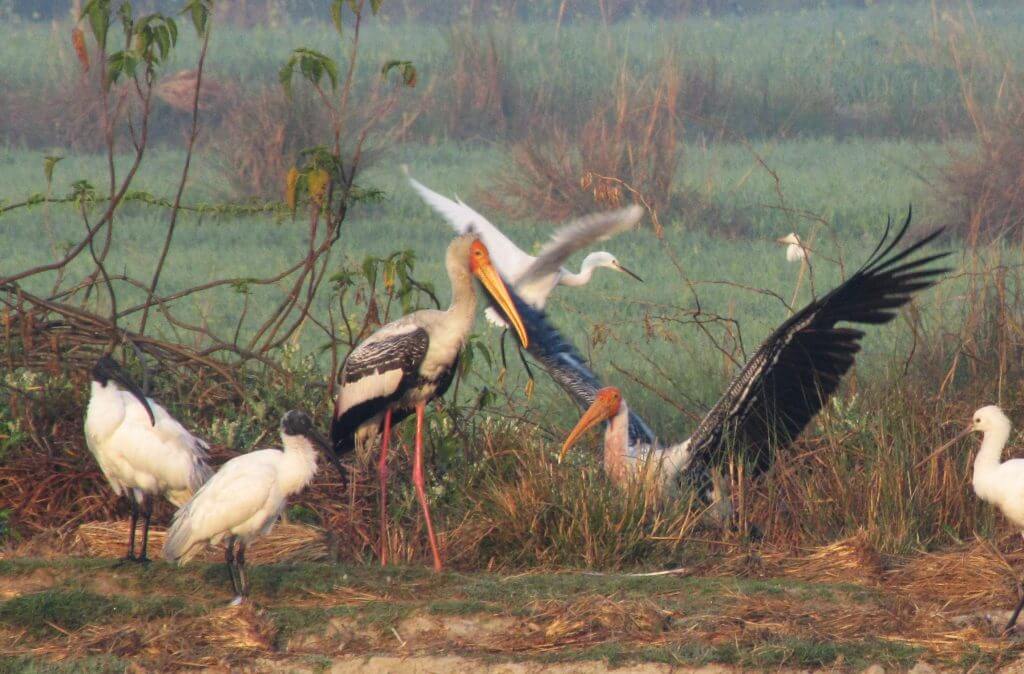
Among the numerous bird sanctuaries in Uttar Pradesh, Lakh Bahosi Bird Sanctuary is one of the most popular and recommended by nature lovers and birdwatchers.
The Lakh Bahosi Bird Sanctuary is located in the Kannauj district of Uttar Pradesh, India. It spreads over two lakes near the village of Lakh and Bahosi. We have traveled about 40 km from Kannauj on Kanpur-Delhi National Highway via Indergarh to reach there.
Lakh Bahosi Sanctuary hosts nearly 49 bird species out of 97 species inhabitant in India. We have seen numerous species of wildlife in the sanctuary ranging from jackals to fishing cats, Blue bulls, mongooses, and monkeys.
It opens at 10 AM and closes at 4 PM. There is an entry fee of Rs 30/- for each person with Rs. 100 for each vehicle. It’s best to visit this place from December to February.
7. Pangot and Kilbury Bird Sanctuary, Nainital, Uttarakhand
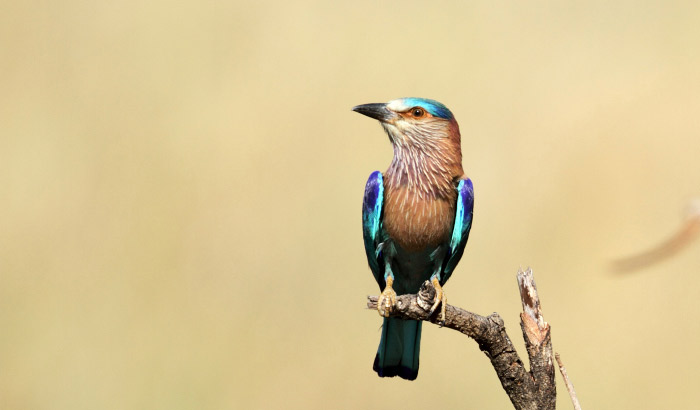
We visit this bird sanctuary in the month of March. Dense forests of the Himalayas, including Nainital, make a perfect habitat for birds to thrive.
The sanctuary is easily accessible from Delhi, making it an ideal destination for avid birdwatchers. Avian enthusiasts can spot a variety of birds in these forests, both indigenous and migratory.
The Himalayas are a popular location for birdwatchers, so make sure to check out the local wildlife! The sound of birds amid the serene forest environment in the Himalayas literally feels like music to our ears.
If you’ve got a pair of binoculars and a camera you’ll get the chance to see some amazing species of birds. You could get to watch blue-winged minla, Himalayan griffon, woodpecker, Rufous-bellied woodpecker Khalij pheasant.
The sanctuary opens at 6 AM and closes at 5 PM. There is no entry fee. The best time to visit Pangot and Kilbury Bird Sanctuary is in the months of March, April, May, and June.
Birding Sarus Crane and Painted Stork
One of my personal favorites birds to watch is the Sarus Crane. These enormous birds can be seen standing nearly 5 feet tall and have a wingspan of over 8 feet. Watching them strut around in their natural habitat is an incredible experience.
Another great bird to watch is the Painted Stork in these wetlands. These beautiful birds are easily recognized by their bright pink, black and white coloring. They’re also one of the largest storks in the world, measuring in at over 3 feet tall. Watching them fly overhead is a truly majestic sight.
Sarus Crane
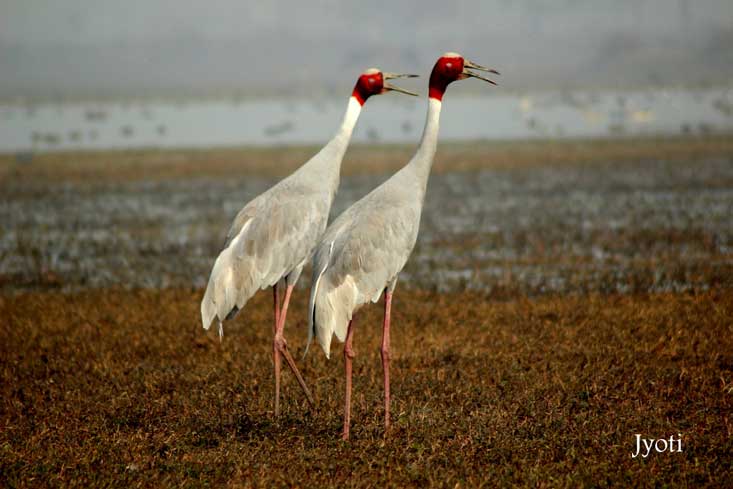
Apart from its physical characteristics, Sarus Crane caught our attention because of the example it presents of ‘companionship’. You would see these sensitive birds mostly in pairs; eating, calling, dancing, or hanging around, they are always together.
During our trips to many bird sanctuaries this winter, we could see Sarus Crane at quite a few places namely Bharatpur (Rajasthan), Sultanpur (Haryana), Basai (Haryana), and Dhanauri (Uttar Pradesh), and it was the latter where we could see Sarus crane from close to the extent that we could click and observe them.
Painted Stork
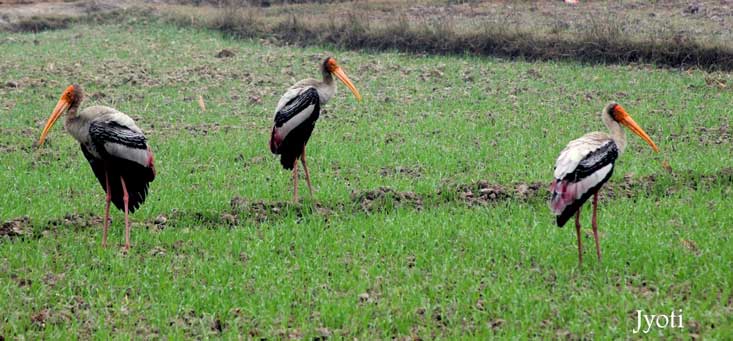
Painted storks are abundantly available in many places like Dighal, Dhanauri, and Sultanpur.
While you can watch them form close at the first two places, there is stock full of Painted Storks (both adults and juveniles) at Sultanpur Bird Sanctuary, this winter. Be ready to get mesmerized by looking at the resting and flying solo and in flocks.
A Quick Checklist for Your Next Birding Visit
If you’re new to birding, or just want to brush up on your skills, follow this quick checklist for a successful outing.
First, find a good spot. This could be a nature reserve, park, or any other area with plenty of wildlife.
Then, familiarize yourself with the types of birds that live in your area. There are many resources available online and in libraries to help you get started.
Next, equip yourself with the right gear. A good pair of binoculars is essential, as well as a hat, sunscreen, and insect repellent. A basic list is the following –
- Water bottle
- Snacks/fruits
- Sport shoes
- Cap/hat
- Sunglasses (if needed)
- Gloves (if cold)
- Camera
- Binoculars
- Birding Book (My pick- ‘Birds of India’ by Norman Arlott)
Finally, practice patience and enjoy the experience! Birding can be addictive, so make sure you take your time and soak up all the beauty around you.
Read our complete guide on Bird Watching for more details. Bird Watching – Why and How You Should Do Birding
Pinning it down
By now you know where to go birding if you too are a fan of Painted Storks or Sarus Cranes. Natural bird sanctuaries or wetlands nearby agricultural lands prove to be a good site to observe your favorite birds from a close distance.
While Bird Sanctuaries in Delhi are your immediate preference, these trips offer you a distinct experience. If you’re looking for an incredible birding experience, be sure to check out one of these natural bird sanctuaries near Delhi!
Not only will you get to see some beautiful and rare birds, but you’ll also be doing your part in helping to preserve their habitats. So what are you waiting for? Go get your Camera and Binoculars to experience what this spring can offer you!
Also, do not forget to inform us which place you liked the most and why. Let birds spring in your life! 🙂
